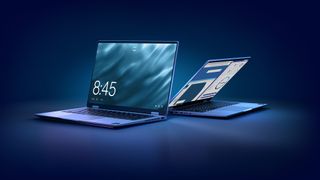
The growth of hybrid working during the global pandemic has underlined the importance of being able to rely on your business hardware fleet. While employees might tolerate having a less-than-current system on their office desk, having out-of-date equipment for home working simply added frustration to an already difficult situation. Now that the hybrid pattern is becoming the norm for many organizations, it’s imperative that companies equip their employees properly. Refreshing the corporate fleet might appear daunting, but it will be essential for the new normal of work. Here are some tips to help smooth the process.
Before considering the steps to take, it's also worth underlining that, now employees have tasted the benefits of a flexible working model, making this available and as seamless as possible is becoming an essential employee incentive. An Ernst & Young survey of over 16,000 employees across 16 countries showed that 54% would consider leaving their job if not offered some form of flexible working pattern. This shows that providing the necessary technological investment to enable this mode is fundamental for employee retention and attracting new recruits.
There is extensive evidence now that flexible working doesn’t impact productivity or can even improve it, and employees know that, so companies that don’t facilitate it risk losing the best employees to companies that do. Your PCs need to serve the needs of your workers and business as a whole, delivering security, performance, manageability and stability to support productivity and the work of IT teams while protecting your network from breaches.
Kickstarting your refresh
The first step is to make sure you have a clear idea of the current PC fleet and its capabilities. Your organization should already have a solid asset-tagging system in place, and this will be a core piece of information during the refresh. Allied with this is getting a clear idea of employee needs, which could be radically different for hybrid work. Up until the pandemic, most employees will probably have been bound to an office desk, so their desktop system may have sat largely dormant for most of the last two years, thanks to the numerous lockdowns. This system won’t be so valuable for a hybrid model. Unless this desktop system was shipped out for use at home, or a laptop culture was already in place, employees may have been using their personal equipment for work, leading to numerous problems of compatibility and security. Refreshing the PC fleet for hybrid working alleviates these problems.
Alongside auditing the current fleet, you should get planning for the refresh as soon as possible. Once you have an idea what employees want, and what they need for their everyday tasks, the search for the most appropriate systems to fulfill requirements can begin. Needs will vary, because a system that is good for general office software, internet usage and cloud-based applications might not be up to scratch for demanding tasks such as graphics or media work. Some employees will need greater portability than others, and some might benefit from ‘transformer’ devices with tablet and presentation modes alongside conventional laptop abilities.

Equipping employees for remote work can be greatly facilitated if a device-as-service (DaaS) provision is available. This can be combined with a consistent set of hardware specifications that can be supplied from a known brand to streamline deployment. A standard corporate configuration can be delivered remotely to off-the-shelf employee systems without the need to bring devices to the company’s IT department for preparation. Not only is this quicker, but with a global device vendor this can make it possible to equip employees in a more diverse range of locations. Linked to the ability to centrally manage the deployment of remote systems is control over data. If the device is lost or an employee leaves the company, having the option to remove sensitive information without direct physical access ensures corporate data integrity is maintained.
Once a range of devices has been defined, it’s worth budgeting to keep a selection of reserve equipment available to hot swap in the case of accidental damage or when an employee has left their device at home.
The right platform
All these stages in a successful refresh are greatly facilitated by having a hardware platform that can be depended on to deliver secure manageability for a wide range of different system specifications. Intel vPro® provides robust security and management tools that allow for remote diagnosis, repair and protection of user devices. This dependable remote access makes the hybrid working model easier to deploy and maintain.
Intel vPro® also delivers the performance and range of device types to satisfy the full scope of employee work scenarios. Whether a worker requires a multi-format device for complete flexibility, or uncompromising performance, Intel vPro® provides the security, performance, manageability and stability they need. A comprehensive range of internationally renowned PC brands have created innovative, cutting-edge Intel vPro®-based laptops, ensuring employees can be furnished with a device that perfectly fits their work requirements.

Providing a versatile, secure and reliable device is central to delivering the hybrid working environment employees now demand, and employers are starting to realize they must equip their employees with the hardware they want and need. A recent IDC report revealed that 72% of IT decision makers recognized that device choice is very important in their ability to recruit and retain talent. Similarly, 64% of workers said that the device they are given affected their productivity, with 62% saying this impacted their satisfaction levels. The IDC report also found that a further 56% claimed that the technology provided would affect their willingness to stay with a company over an extended period.
Refreshing your company’s PC fleet for the brave new world of hybrid work doesn’t need to be daunting, but it is a necessity. If you follow the steps we have defined here and choose dependable devices like those based on Intel vPro you can be sure to give your employees the systems they need to work efficiently. This will deliver the best incentive to retain staff and ensure your company thrives as hybrid working becomes the employment norm.
Intel technologies may require enabled hardware, software or service activation. No product or component can be absolutely secure. Your costs and results may vary.
@Intel Corp. Intel, the Intel logo, Intel vPro® and other Intel marks are trademarks of Intel Corporation or its subsidiaries. Other names and brands may be claimed as the property of others.
Get the ITPro. daily newsletter
Receive our latest news, industry updates, featured resources and more. Sign up today to receive our FREE report on AI cyber crime & security - newly updated for 2024.
ITPro is a global business technology website providing the latest news, analysis, and business insight for IT decision-makers. Whether it's cyber security, cloud computing, IT infrastructure, or business strategy, we aim to equip leaders with the data they need to make informed IT investments.
For regular updates delivered to your inbox and social feeds, be sure to sign up to our daily newsletter and follow on us LinkedIn and Twitter.





